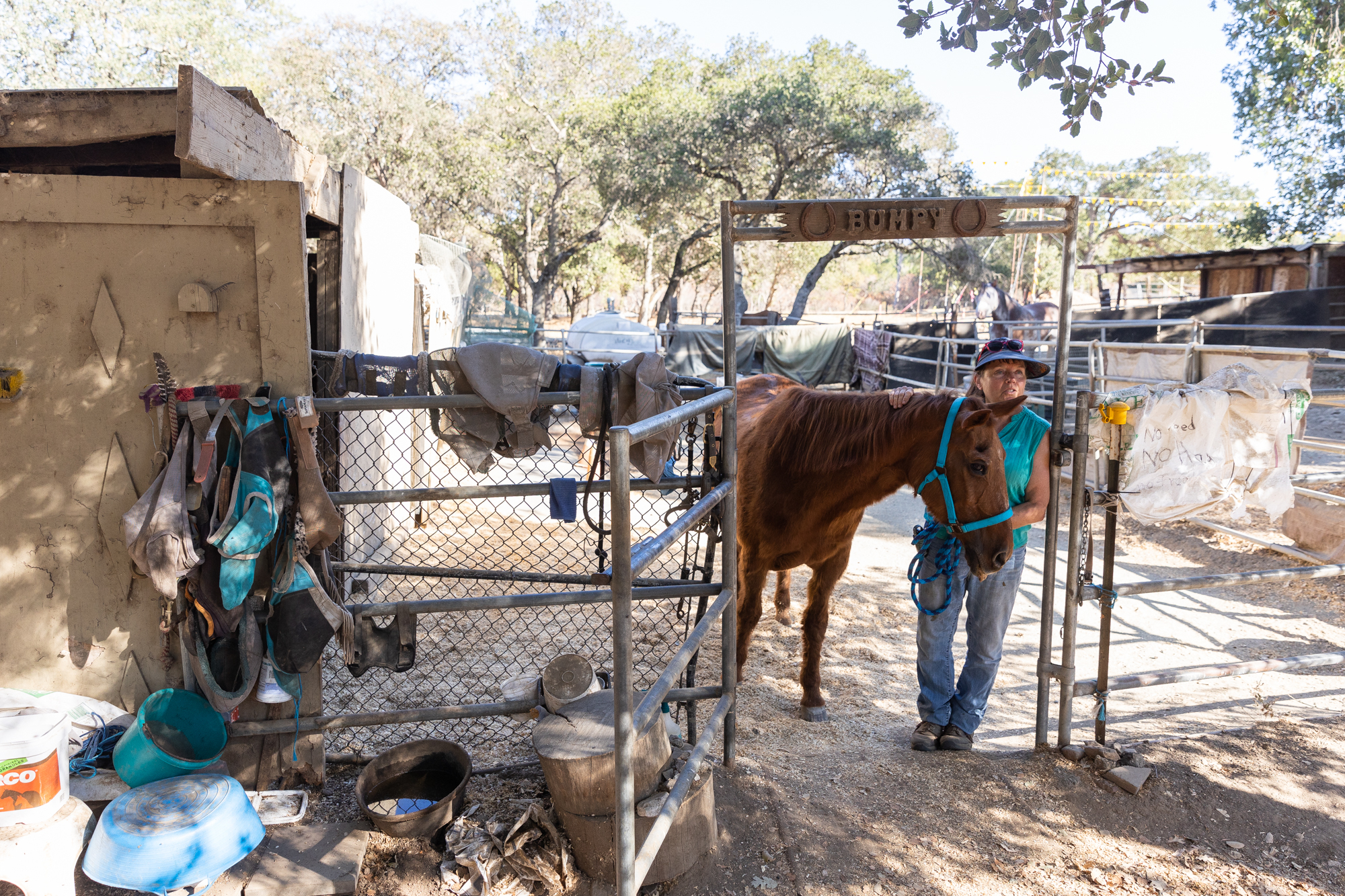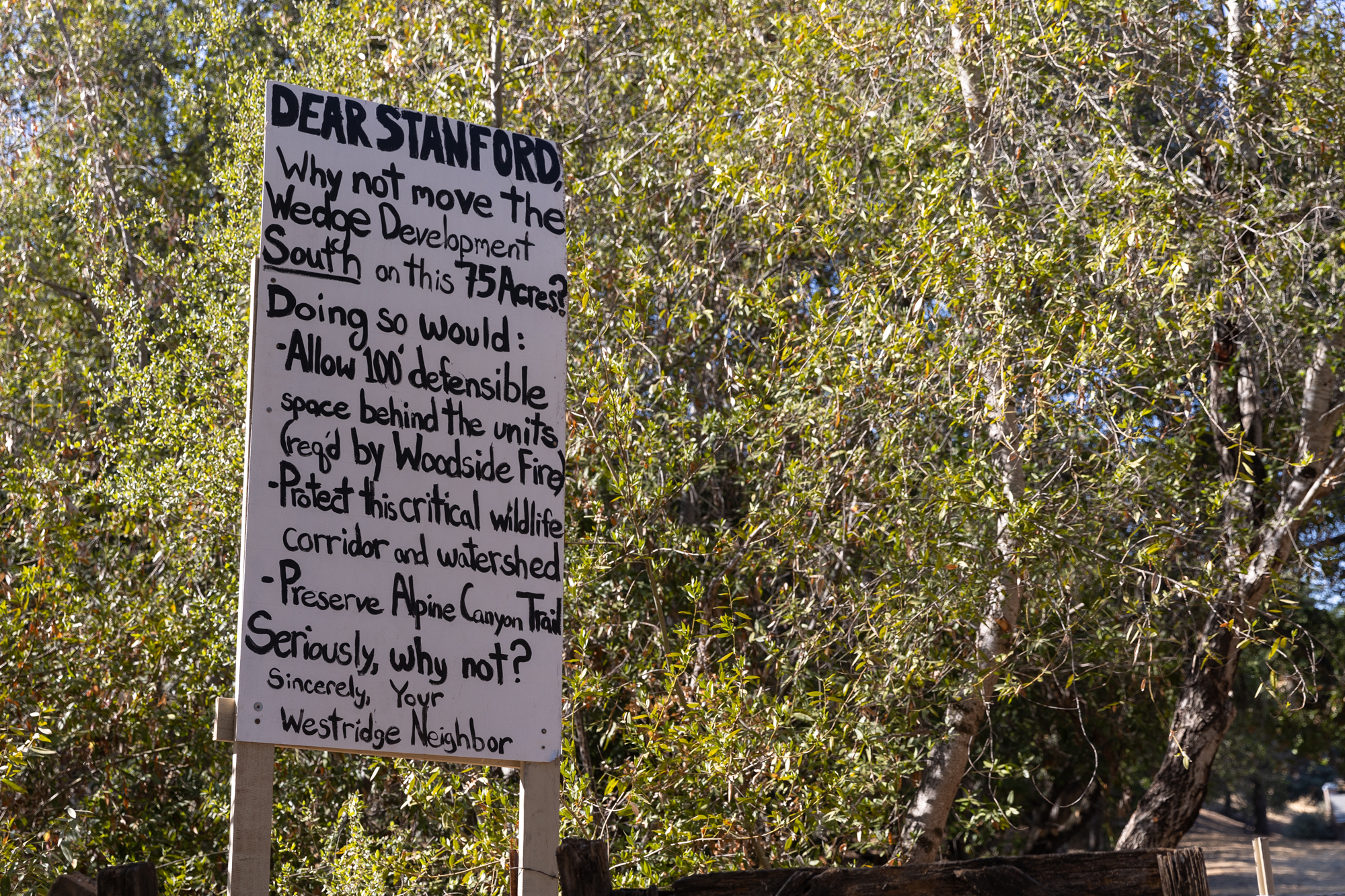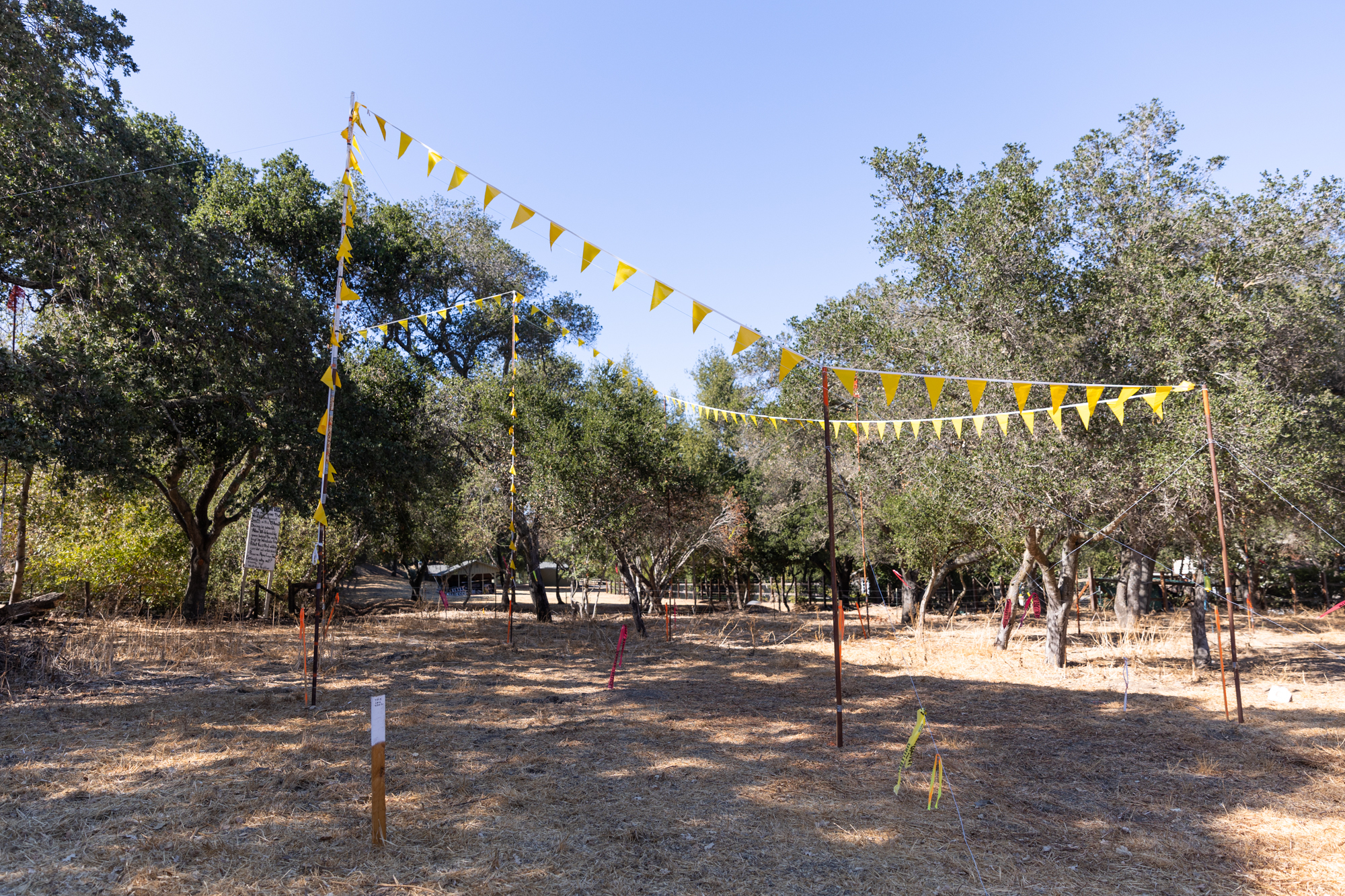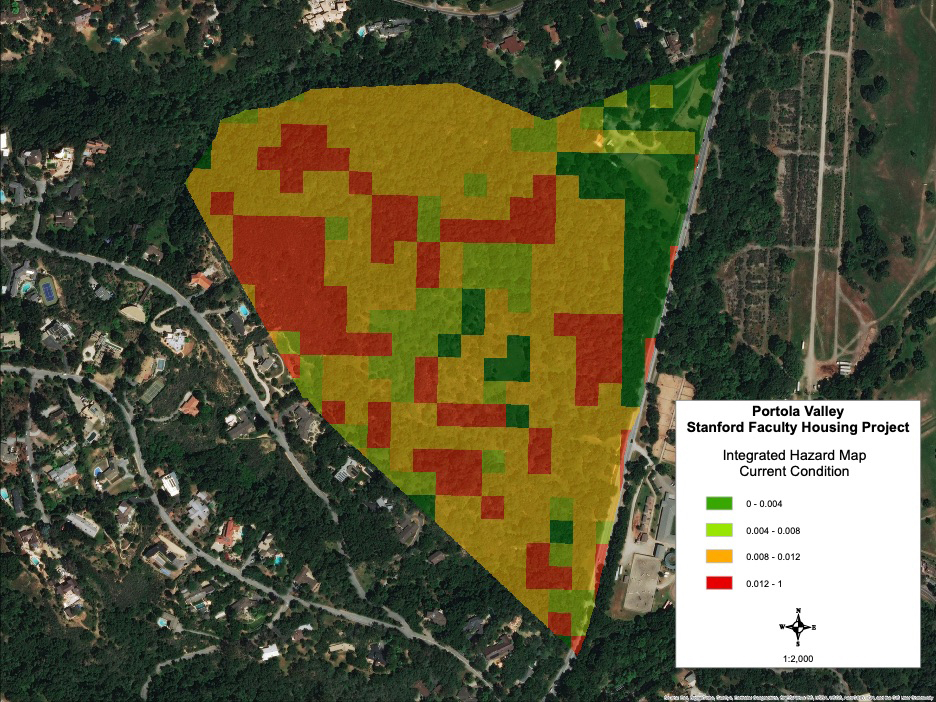A wooden arch above the entrance to a stable at Portola Valley's Alpine Rock Ranch is etched with the name "Bumpy" for its longtime inhabitant.
The 39-year-old brown quarter horse mare is in good health, other than some discoloration on her tongue from old age. What's precarious is the future of her home of 28 years on the Stanford Wedge property at 3530 Alpine Road, where she and eight other horses live. The 6-acre site, owned by Stanford University, is the proposed location of the university's Portola Terrace housing development.
"We want to keep the ranch," said Joan Kuntz, Bumpy's owner of 25 years, calling the possible loss of the land "tragic." "It's a home for the horses. ... Hopefully people won't let it happen. It would be devastating for Bumpy to have to move; as they (horses) get older, they get more sensitive."
Kuntz, Redwood City resident, describes Bumpy as her "biggest best buddy" and her "horse soulmate."
The project, which includes 39 housing units on part of the Wedge's 75 acres located between Westridge and Golden Oak drives, was initially proposed over two years ago, and ever since, residents have cited potential traffic jams and fire hazards for opposing the development plans.
Last week, Stanford officials hosted public site tours to anyone interested in seeing where buildings would be placed if the development gets the go-ahead from the Town Council. About 120 people signed up for tours, said John Donahoe, director of planning and entitlements at Stanford.
Portola Terrace would include 27 single-family residences for Stanford faculty and 12 workforce housing units that would be available for below market rate rents.
During the tour, officials used stakes to indicate where certain buildings would be, and how tall they would be, by using color coded flags.
An environmental impact report for the project is expected this fall, said Town Manager Jeremy Dennis.
A resident whose home borders the property erected a large white sign denouncing the project within 24 hours of the Thursday afternoon site tour, according to Stanford officials.
Stanford is trying not to react to any one person's opinion on the project until the environmental impact report is released, Donahoe said.
Fire safety
Most of the property will remain as an oak woodland and there's a vegetation management plan for the site. Elevations within the project site range from approximately 323 feet to 678 feet above sea level. The area of proposed development is on the flattest portion of the site. The vegetation management plan, together with fire prevention measures in the housing development, will "significantly improve fire safety for the surrounding residents and community," according to Stanford.
A former firefighter walked "every square foot" of the site plan to make sure aerial vegetation maps were accurate, said Donahoe. The site is mostly populated by oak woodland trees.
Stanford hasn't cut down any trees yet, but it has removed branches and cleared brush as part of its initial fire mitigation efforts, Donahoe said.
Two fire behavior modeling programs — computer simulations that reproduce characteristics like how quickly a fire can spread, in which directions and how much heat it may generate given the conditions of the fuels, land, and predicted weather — were used to assess the probability and intensity of fire on the property and to identify effective ways to lower the likelihood of a fire breaking out and spreading, according to the vegetation plan. Fire behavior modeling also looks at whether a fire would transition from the ground surface to tree crowns, which is much more dangerous.
Once fire behavior is estimated through modeling, an assessment of fire hazards to surrounding life and property can be done and modifications, known as vegetation treatments or prescriptions, can be made.
Nearly all areas of the property were shown to need some form of vegetation treatment to reduce fire hazard. The modeling shows that fire safety on the entire property is significantly improved with the vegetation plan, which is part of the development application for Portola Terrace, according to the vegetation plan. Average flame lengths are greatly diminished from 4.8 feet to 0.7 feet and "integrated hazard" decreases by as much as 99%. This greatly reduces fire risk to surrounding homes and infrastructure, the plan states.
A new private permanent road will be constructed from Alpine Road up to the middle of the property to allow for greater fire engine access since currently parts of the mountain can only be accessed through other residents' properties.
Environmental protections are also incorporated into the fire plan, including protection of significant trees, nesting birds, San Francisco dusky-footed woodrats, California red-legged frogs, and archaeological resources.
State housing requirements
The state is mandating that the town plan for building much more housing than it has in past housing element cycles.
Portola Valley is required to designate 253 new housing units in the next decade, the council has also been weighing the concept of adding housing while also preserving Portola Valley's treasured rural character and not creating more wildfire risk in the process. In the last Regional Housing Needs Allocation (RHNA) cycle, the California Department of Housing and Community Development assigned just 64 units to Portola Valley.








Comments
Registered user
Portola Valley: other
on Sep 1, 2021 at 8:03 pm
Registered user
on Sep 1, 2021 at 8:03 pm
Absolutely horrific spot for housing, and the Fire Marshall has been crustal clear that this is the WORST place for density. I saw those story poles today—-are you kidding? There isn’t another structure on Alpine Road that sits that close to the road and is two stories tall. Even the church is set back further. Stanford said that the housing would be set much further back into the landscape (which also adds to fire danger) and here we go again—-Stanford not following through on promises. The Town Council is so intent on housing—they literally refused to fight this mandate, in spite of multiple other communities doing so—and are not listening to anything that our town citizens or fire experts are telling them. In fact, Stanford was not even considering developing this site until a member of the Town Council contacted them about it directly. Seeing that member then feature in another article about losing their fire insurance—-what an absolute crock. What a disaster this whole thing is.
Registered user
Portola Valley: Westridge
on Sep 2, 2021 at 7:19 am
Registered user
on Sep 2, 2021 at 7:19 am
WOW, ABSOLUTELY UNBELIEVEABLE. The way this is even being considered is beyond me. Just look at the Caldor fire!!! Why has the council been so motivated to develop this? The whole thing is suspicious!!!
Registered user
Menlo Park: Sharon Heights
on Sep 2, 2021 at 8:40 pm
Registered user
on Sep 2, 2021 at 8:40 pm
Are readers supposed to get teary that one old horse will have to move to a new pasture to make way for a group of middle-income Stanford families with young kids? (Or is Portola Valley getting teary because they love that the second sentence of their wikipedia entry reads "In 2016 it had the highest per-capita income among U.S. communities with a population larger than 4,000.[5]."
Are readers supposed to believe that modest housing along with vegetation management on this parcel will somehow increase fire danger to Portola Valley? Ummmm. It's pretty well known now that wildfires are predominately burning in places where vegetation is NOT managed.
PLEASE. Not only does Portola Valley need to wake up to itself, but the Almanac needs to stop publishing junk like this.
Registered user
Menlo Park: Linfield Oaks
on Sep 3, 2021 at 1:11 pm
Registered user
on Sep 3, 2021 at 1:11 pm
Happy to see a voice of reason from La Estrada parent! 100% agree, including the journalistic decision to focus on the horse when housing is such an urgent unmet need.